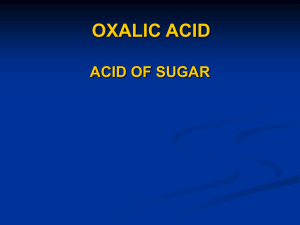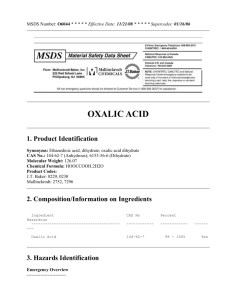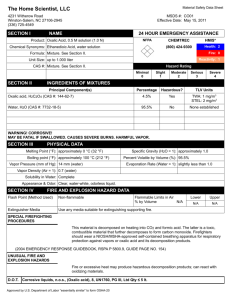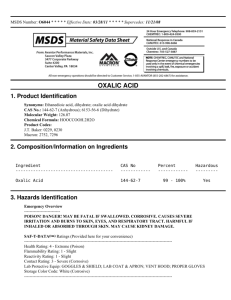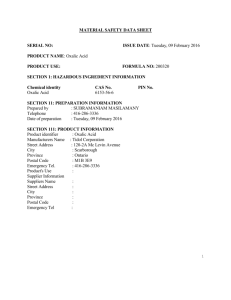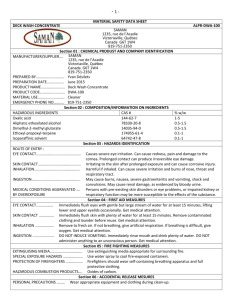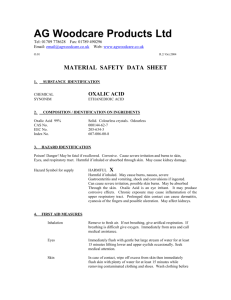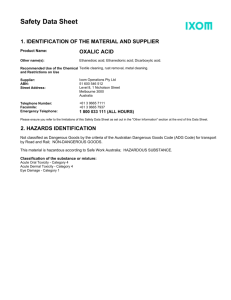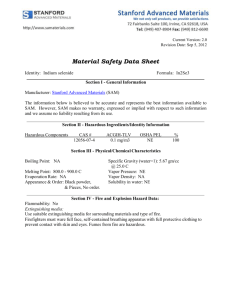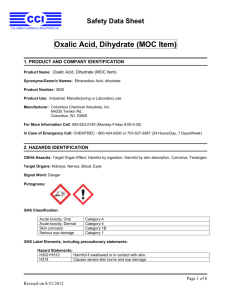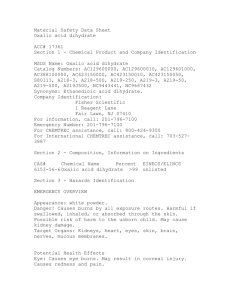Oxalic Acid MSDS: Hazards, Safety & Handling
advertisement
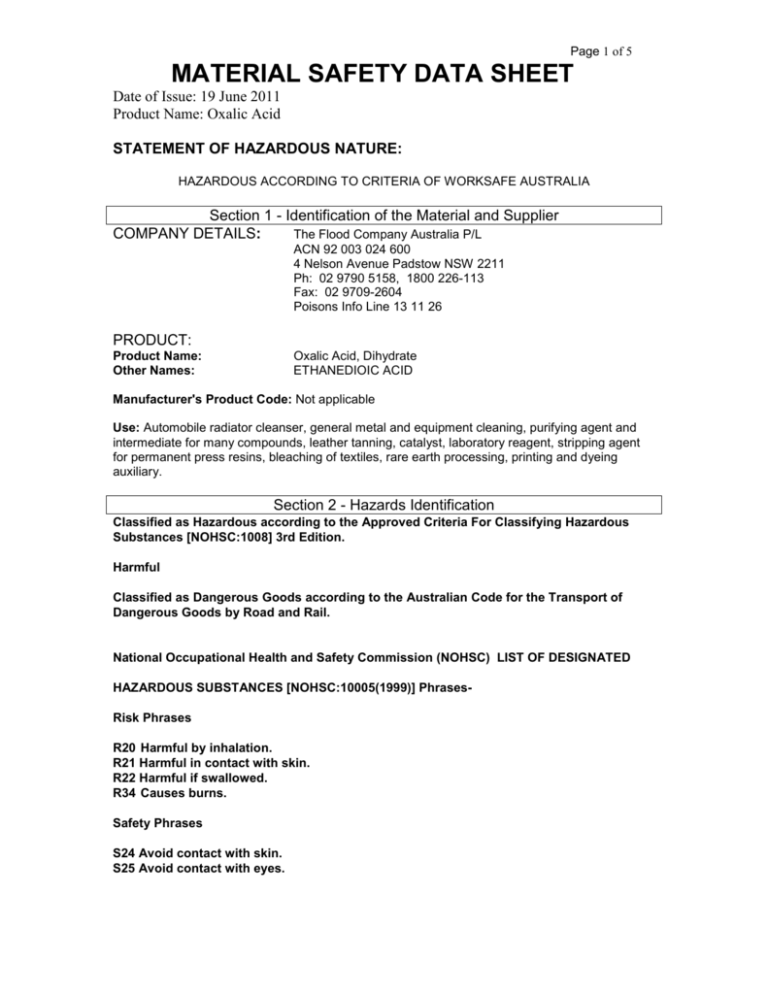
Page 1 of 5 MATERIAL SAFETY DATA SHEET Date of Issue: 19 June 2011 Product Name: Oxalic Acid STATEMENT OF HAZARDOUS NATURE: HAZARDOUS ACCORDING TO CRITERIA OF WORKSAFE AUSTRALIA Section 1 - Identification of the Material and Supplier COMPANY DETAILS: The Flood Company Australia P/L ACN 92 003 024 600 4 Nelson Avenue Padstow NSW 2211 Ph: 02 9790 5158, 1800 226-113 Fax: 02 9709-2604 Poisons Info Line 13 11 26 PRODUCT: Product Name: Other Names: Oxalic Acid, Dihydrate ETHANEDIOIC ACID Manufacturer's Product Code: Not applicable Use: Automobile radiator cleanser, general metal and equipment cleaning, purifying agent and intermediate for many compounds, leather tanning, catalyst, laboratory reagent, stripping agent for permanent press resins, bleaching of textiles, rare earth processing, printing and dyeing auxiliary. Section 2 - Hazards Identification Classified as Hazardous according to the Approved Criteria For Classifying Hazardous Substances [NOHSC:1008] 3rd Edition. Harmful Classified as Dangerous Goods according to the Australian Code for the Transport of Dangerous Goods by Road and Rail. National Occupational Health and Safety Commission (NOHSC) LIST OF DESIGNATED HAZARDOUS SUBSTANCES [NOHSC:10005(1999)] PhrasesRisk Phrases R20 Harmful by inhalation. R21 Harmful in contact with skin. R22 Harmful if swallowed. R34 Causes burns. Safety Phrases S24 Avoid contact with skin. S25 Avoid contact with eyes. Page 2 of 5 MATERIAL SAFETY DATA SHEET Date of Issue: 19 June 2011 Product Name: Oxalic Acid NFPA Rating: (estimated) Health: 3; Flammability: 1; Reactivity: 0 Section 3 - Composition/Information on Ingredients Oxalic Acid Dihydrate Chemical Formula: CAS #6153-56-6 C2H2O4.2H2O Section 4 First Aid Measures Swallowed: Rinse mouth, then drink 1 or 2 large glasses of water, DO NOT induce vomiting. Never give anything by mouth to an unconscious person. Seek immediate medical assistance. Eye: Immediately flush eyes with plenty of water holding eyelids open. Seek immediate medical assistance. Skin: Remove contaminated clothing. Flush skin with cool running water. Wash thoroughly with soap and water. Wash contaminated clothing before reuse. Seek immediate medical assistance. Inhaled: Remove victim from exposure to fresh air. If breathing is difficult, give oxygen. Seek immediate medical assistance. Advice to Doctor Treat symptomatically based on individual reactions of patient and judgement of Doctor. If victim is conscious, give immediately by mouth, a fine suspension in water of a non-toxic calcium compound such as calcium lactate, chalk, plaster or milk. Large amounts of calcium are required to inactivate oxalate by precipitating it as the insoluble calcium oxalate salt. Aggravated medical conditions caused by exposure Long term exposure to oxalic acid solutions, by ingestion, skin absorption and inhalation is linked to stone formation in kidney and urinary tract. Painful abdominal spasms during the passing of the stone and painful and difficult urination may occur. Secondary products cause damage to kidneys. Section 5 Fire Fighting Measures Product is a combustible solid. In case of fire, appropriate extinguishing media include; Small fire- Use dry chemical, carbon dioxide, water spray or foam. Large fire- Use water spray, fog or foam. Hazard from Combustion Products Combustible solid. Incompatible with oxidizing agents, acids, bases, alkali metals, iron, iron compounds, silver and sources of ignition. May be ignited by friction, heat, sparks or flame. May re-ignite after fire is extinguished. Solids may melt and flow when heated or involved in a fire. Containers may explode when heated. Fire may produce irritating, poisonous and/or corrosive gases, carbon monoxide, carbon dioxide and formic acid. Special protective precautions and equipment for fire fighters Fire fighters should wear a self contained breathing apparatus and full protective clothing along with protective equipment. Page 3 of 5 MATERIAL SAFETY DATA SHEET Date of Issue: 19 June 2011 Product Name: Oxalic Acid Section 6 Accidental Release Measures Emergency Procedures Personnel involved in the clean up should wear full protective clothing. Eliminate all sources of ignition. Increase ventilation. Avoid generating dust. Do not allow product to reach drains, sewers or waterways. Use spark-proof tools and equipment. Methods and materials for containment and clean up Contain and sweep up spills with dust binding material or use an industrial vacuum cleaner. Transfer to a suitable, labeled container and hold for safe disposal. Section 7 Handling and Storage Precautions for safe handling Ensure an eye bath and safety shower are available and ready for use. Observe good personal hygiene practices and recommended procedures. Wash thoroughly after handling. Take precautionary measures against static discharges by bonding and grounding equipment. It is advisable to use rubber gloves and eye/skin protection when handling the solid material and the aqueous solution that is often prepared. Conditions for safe storage, including any incompatibles Store in a cool, dry, well-ventilated area. Keep containers tightly closed when not in use. Inspect regularly for deficiencies such as damage or leaks. Protect against physical damage. Store away from incompatible materials including oxidizing agents, acids, bases, alkali metals, iron, iron compounds, silver and sources of ignition. Protect from direct sunlight, moisture and static discharges. Section 8 Exposure Controls/Personal Protection Engineering Controls: Facilities storing or utilizing this material should be equipped with an eyewash facility and a safety shower. Use adequate general or local exhaust ventilation to keep airborne concentrations below the permissible exposure limits. Exposure Limits Chemical Name ACGIH 1 mg/m3 TWA; 2 mg/m3 STEL Oxalic acid dihydrate none listed Oxalic acid, anhydrous NIOSH 1 mg/m3 TWA 500 mg/m3 IDLH none listed OSHA - Final PELs 1 mg/m3 TWA none listed Personal Protective Equipment Eyes: Wear appropriate protective eyeglasses or chemical safety goggles as described by OSHA's eye and face protection regulations in 29 CFR 1910.133 or European Standard EN166. Avoid contact with eyes Skin: Wear appropriate protective gloves to prevent skin exposure. Avoid contact with skin Clothing: Wear appropriate protective clothing to prevent skin exposure. Respirators: Do not breathe dust.Follow the OSHA respirator regulations found in 29CFR 1910.134 or European Standard EN 149. Always use a NIOSH or European Page 4 of 5 MATERIAL SAFETY DATA SHEET Date of Issue: 19 June 2011 Product Name: Oxalic Acid Section 9 Physical and Chemical Properties Appearance: white crystals Melting point: 104 - 106 C Boiling point: 149 - 160C (300 - 320F) Sublimes. Vapour density: 4.4 Vapour pressure: < 0.01 mm Hg at 20 C Density (g cm-3): 1.65 Solubility: Soluble in water. Specific Gravity: 1.65 @ 18.5C/4C % Volatiles by volume @ 21C (70F): 0 Section 10 Stability and Reactivity Chemical Stability: Product is stable under normal conditions of use, storage and temperature. Conditions to Avoid: Avoid excessive heat, generating dust, direct sunlight, moisture, static discharges and high temperatures. Incompatible Materials Incompatible with oxidizing agents, acids, bases, alkalis, metals, salts of oxyhalogenic acids, ammonia and sources of ignition. Hazardous Decomposition Products Product may generate carbon monoxide, carbon dioxide and formic acid. Hazardous Reactions Hazardous polymerization will not occur. Section 11 Toxicological Information Toxicity data ORL-WMN LDLO 600 mg kg-1 (Oral woman lowest published lethal dose) ORL-RAT LD50 7500 mg kg-1 UNR-RAT LD50 1400 mg kg-1 Ingestion Harmful if swallowed. May cause irritation of mucous membranes in the mouth, pharynx, oesophagus and gastrointestinal tract. May cause rapid absorption. After absorption may cause agitation, spasm, nausea, vomiting, cardiovascular failure, collapse. Disturbed electrolyte balance. Eye Severe eye irritant. May cause redness, pain and damage to the cornea. If damage is restricted to the outer layer of the eye, recovery may occur within a few days. Prolonged contact with oxalic acid solutions can produce irreversible eye damage. Skin Harmful in contact with skin. Irritant and caustic effects, tissue damage. Danger of skin absorption. Solutions of 5-10% acid are irritating to the skin after prolonged exposure and can Page 5 of 5 MATERIAL SAFETY DATA SHEET Date of Issue: 19 June 2011 Product Name: Oxalic Acid cause corrosive injury. Excessive contact may produce a delayed localized pain, discolouration of the skin with fingernails becoming brittle and blue-coloured, ulcers and gangrene. Inhaled Irritation of mucous membranes, coughing and dyspnoea. Section 12 Ecological Information Ecotoxicity: Ecotoxicity in water (LC50): 4000 mg/l 24 hours [Fish (Bluegill)]. 1000 ppm 0.5 hours [Fish (Goldfish)]. 100 ppm 0.3 hours [Fish (Trout)]. BOD5 and COD: Not available. Products of Biodegradation: Possibly hazardous short term degradation products are not likely. However, long term degradation products may arise. Toxicity of the Products of Biodegradation: The products of degradation are less toxic than the product itself. Special Remarks on the Products of Biodegradation: Not available. Section 13 Disposal Considerations Chemical waste generators must determine whether a discarded chemical is classified as a hazardous waste. US EPA guidelines for the classification determination are listed in 40 CFR Parts 261.3. Additionally, waste generators must consult state and local hazardous waste regulations to ensure complete and accurate classification. Section 14 Transport Information Transport within user's premises: Always transport in closed containers that are upright and secure. Ensure that persons transporting the product know what to do in the event of an accident or spillage. This product is a dangerous good for transport UN Number: 3261 UN Proper Shipping Name. Corrosive Solid, Acidic, Organic, n.o.s. (Oxalic Acid, Dihydrate) Class and subsidiary risk(s): 8 Packaging group: III Hazchem Code: 2X Section 15 Regulatory Information NFPA Rating: (estimated) Health: 3; Flammability: 1; Reactivity: 0 Section 16 Other Information Keep out of reach of children. The above information is believed to be correct with respect to the formula used in manufacture of the product. As data, standards and regulations change, and conditions of use and handling are beyond our control,NO WARRANTY. EXPRESSED OR IMPLIED, IS MADE AS TO THE COMPLETENESS OR CONTINUING ACCURACY OF THE INFORMATION
